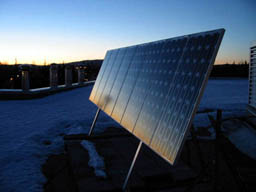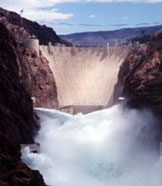|
CONSERVATION
Energy
efficiency is
the most immediate way to reduce both our dependence on foreign
oil, and the level of greenhouse gasses produced.
Strong government
policies can have significant impact in the conserving of fuel,
from emissions standards on cars to the use of energy efficient
light bulbs to the use of hybrid cars in all government fleets.
Because of robust efficiency
policies, California has the lowest per capita energy consumption
in the nation.
Check out
the Flex Your
Power campaign that reduced power demand by 5000 megawatts
in 2001. The technology exists. We need leadership.
Since home
appliance efficiency standards were enacted in 1987, manufacturers
have nearly tripled refrigerator efficiency! Government
has a role to play.
WIND
During 2005,wind turbines operating in the United
States offset the emission of 3.5 million tons of carbon
dioxide,while reducing natural gas demand for power generation
by 4–5 %. |
 |
Wind
farms can be permitted and built far faster than conventional
power plants.And by some estimates, every 100 MW of wind
capacity creates 200 construction jobs, 2–5 permanent
jobs,and up to $1 million in local property tax revenue.
|
SOLAR
Solar power
plants that concentrate sunlight in desert areas require 2,540
acres per
billion kWh.On a lifecycle basis,this is less land than a comparable
coal or hydropower
plant requires, and because most deserts are sparsely populated,
there is plenty of room for
solar power plants.
 |
A
little over 4,000 square miles—equivalent to 3.4 percent
of the land in New Mexico—would be sufficient to produce
30 percent of the country’s electricity. |
In
addition,sunlight can be used to produce power without using
any land at all,simply by installing solar cells on the available
roofs and walls of U.S.buildings.It is estimated that the nation
has 6,270 square miles of roof area and 2,350 square miles of
façades that are suitable for harnessing solar power.
Mounting solar panels on just half of this area could supply
nearly 30% of U.S. electricity.
Annual
global production of solar cells has increased six-fold since
2000.
The U.S.
is the birthplace of the solar cell industry, holding 44 percent
of the solar cell market as recently as 1996. By 2005, that
figure had fallen to 9 percent.
BIOFUELS
Bio
fuel is any fuel that is derived from biomass — recently
living organisms or their metabolic byproducts, such as manure
from cows. It is a renewable energy source, unlike other natural
resources such as petroleum, coal, and nuclear fuels.
GEOTHERMAL
A
highly efficient way to heat homes and businesses: Ground
temperatures about four to six feet below the Earth's surface
remain relatively moderate and constant all year. That's because
the Earth absorbs 47% of all the heat energy that reaches it's
surface from the sun. A geothermal system circulates a water-based
solution through a buried loop system to take advantage of these
constant temperatures.
A
single piece of equipment has the ability to heat and cool your
home, while providing some or all of your home's hot water as
well. Geothermal systems can save you 30% to 70% on your monthly
utility bills.
HYDROPOWER
Hydropower,
which captures the natural energy of flowing and falling
water to generate power. Currently hydropower provides
one fifth of the world's power and 7 percent of power
in the U.S. That percentage could change: of 80,000 dams
in the United States, only 3% are used to generate electricity.
There is a lack of tax incentives to encourage growth.
Once again, government could play a role.
There
is also potential in Marine Energy Technology, the harvesting
of Tidal Power, Ocean current power, Wave Energy, and
Ocean Thermal Energy Conversion (OTEC) which derives power
from the dynamics created between water temperatures.
|
|
Hoover
Dam, located on the Nevada-Arizona border |
|
NUCLEAR
Many
feel that nuclear is the only emission-free solution to our
energy problems. (most
remarkably James Lovelock, author of the Gaia theory).You
won't find agreement on these pages. Aside from the danger of
an accident, and the problem of waste disposal, nuclear plants
will take up to twelve years to build. We need solutions NOW.
POLICY
Track
federal legislation and tell your
senator
and your congressman
you want real solutions with teeth!
•Establish a consistent, predictable, and
long-term framework of rules and incentives. Renewable resource
developers,like other capital financiers,need certainty to make
informed investments.
Government
has a role to play. It has subsidized the oil and gas industry
for decades. It is time to make a change. Time to educate the
consumer, the investor, time to influence the marketplace.
|






